MENU
The Electronic Scholarly Publishing Project: Providing access to classic scientific papers and other scholarly materials, since 1993. More About: ESP | OUR CONTENT | THIS WEBSITE | WHAT'S NEW | WHAT'S HOT
Comparative Timelines
The ESP Timeline (one of the site's most popular features) has been completely updated to allow the user to select (using the timeline controls above each column) different topics for the left and right sides of the display.
Select:
New Left Column
New Left Column
Dates
Decade
New Right Column
New Right Column
(no entry for this year)
1840
 Charles Darwin's Zoology of the Voyage of the Beagle appears.
Charles Darwin's Zoology of the Voyage of the Beagle appears.
Martin Barry expressed the belief that the spermatozoon enters the egg.
The U.S.S. Creole, a ship carrying slaves from Virginia to Louisiana, is seized by the slaves on board and taken to Nassau, where they are free.
 John Tyler becomes tenth president of the United States.
John Tyler becomes tenth president of the United States.
 The first centralized government bureau of statistics is founded in Belgium by the mathematician Lambert Adolphe Jacques Quetelet (1781-1840).
The first centralized government bureau of statistics is founded in Belgium by the mathematician Lambert Adolphe Jacques Quetelet (1781-1840).
1841
(no entry for this year)
 Frederick Douglass leads a successful campaign against Rhode Island's proposed Dorr Constitution, which would have continued the prohibition on black male voting rights.
Frederick Douglass leads a successful campaign against Rhode Island's proposed Dorr Constitution, which would have continued the prohibition on black male voting rights.
In Prigg v. Pennsylvania, the U.S. Supreme Court upholds the Fugitive Slave Law of 1793, stating that slaveowners have a right to retrievetheir "property." In so doing, the court rules that Pennsylvania's anti-kidnapping law is unconstitutional. At the same time, the Supreme Court declares that enforcement of the Fugitive Slave Lawis a federal responsibility in which states are not compelled to participate. Between 1842 and 1850, nine Northern states pass new personal liberty laws which forbid state officials from cooperating in the return of alleged fugitive slaves and bar the use of state facilities for that purpose.
Slavery is abolished in Uruguay.
The Virginia Legislature votes against abolishing slavery.
In Commonwealth v. Hunt, a case involving the Boston Journeyman Bootmakers Society, the Chief Justice of the Massachusetts Supreme Court ruled that trade unions are legal. The ruling revises the common law that treated such unions as criminal conspiracies.
The Massachusetts State Legislature enacts a child labor law that limits the working hours of children under 12 years-old to 10 hours per day.
P. T. Barnum lures crowds of thousands to see his "Feejee Mermaid."
1842
 Charles Darwin's book The Structure and Distribution of Coral Reefs being the first part of the geology of the voyage of the Beagle, is published. During the year Darwin composes an abstract of his theory of species evolution.
Charles Darwin's book The Structure and Distribution of Coral Reefs being the first part of the geology of the voyage of the Beagle, is published. During the year Darwin composes an abstract of his theory of species evolution.
 Carl Wilhelm von Nägeli (1817-1891) publishes Zur Entwicklungsgeschichte des Pollens. His paper describes cell division in plants with remarkable accuracy, and discusses seed formation in flowering plants.
Carl Wilhelm von Nägeli (1817-1891) publishes Zur Entwicklungsgeschichte des Pollens. His paper describes cell division in plants with remarkable accuracy, and discusses seed formation in flowering plants.
Richard Owen names Cetiosaurus, the sixth named dinosaur species.
 Die Thierchemie, by chemist Baron Justus von Liebig (1803-1873), is published, and the science of biochemistry begins.
Die Thierchemie, by chemist Baron Justus von Liebig (1803-1873), is published, and the science of biochemistry begins.
 The term DINOSAUR is coined by Richard Owen (1804-1892) to describe a class of animals that we now believe were dominant on the Earth for approximately 175 million years.
The term DINOSAUR is coined by Richard Owen (1804-1892) to describe a class of animals that we now believe were dominant on the Earth for approximately 175 million years.
 Congress grants S. F. B. Morse $30,000 to build the first telegraph line (Washington to Baltimore).
Congress grants S. F. B. Morse $30,000 to build the first telegraph line (Washington to Baltimore).
1843
Louis Agassiz completes Les Poissons Fossiles describing fossil fish of the world. This single monograph increases tenfold the formally described vertebrates known to science.
 That the nervous system uses electricity in communicating between different parts of the body is demonstrated by Emil Heinrich du Bois-Reymond (1818-1896). He founds the field of electrophysiology.
That the nervous system uses electricity in communicating between different parts of the body is demonstrated by Emil Heinrich du Bois-Reymond (1818-1896). He founds the field of electrophysiology.
(no entry for this year)
1844
 Charles Darwin first outlines his thoughts on natural selection in an unpublished essay.
Charles Darwin first outlines his thoughts on natural selection in an unpublished essay.
 Robert Chambers, a Scottish journalist, publishes (anonymously) his Vestiges of the Natural History of Creation, an early book outlining an evolutionary view of the natural world.
Robert Chambers, a Scottish journalist, publishes (anonymously) his Vestiges of the Natural History of Creation, an early book outlining an evolutionary view of the natural world.
 The second part of the Geology of the Beagle, Charles Darwin's Geological Observations on Volcanic Islands Visited During the Voyage of H.M.S. Beagle, is published. Darwin's book claims to supply evidence for the geological theories of Charles Lyell (1797-1875), from areas that Lyell himself had never seen.
The second part of the Geology of the Beagle, Charles Darwin's Geological Observations on Volcanic Islands Visited During the Voyage of H.M.S. Beagle, is published. Darwin's book claims to supply evidence for the geological theories of Charles Lyell (1797-1875), from areas that Lyell himself had never seen.
 That all the cells in an organism are generated from successive divisions of the egg cell is described by Rudolf Albert von Kölliker (1817-1905). Kölliker shows that the egg is itself a cell.
That all the cells in an organism are generated from successive divisions of the egg cell is described by Rudolf Albert von Kölliker (1817-1905). Kölliker shows that the egg is itself a cell.
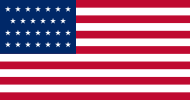 The US flag is modified to have twenty-seven stars, reflecting the addition of one new state: Florida.
The US flag is modified to have twenty-seven stars, reflecting the addition of one new state: Florida.
 Frederick Douglass publishes his autobiography, The Life and Times of Frederick Douglass.
Frederick Douglass publishes his autobiography, The Life and Times of Frederick Douglass.
 James K. Polk becomes eleventh president of the United States.
James K. Polk becomes eleventh president of the United States.
Texas is annexed by the United States.
The Irish potato famine begins, one of the century's worst natural disasters. One million citizens starve to death, and one million others emigrate, mostly to the United States
1845
(no entry for this year)
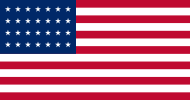 The US flag is modified to have twenty-eight stars, reflecting the addition of one new state: Texas.
The US flag is modified to have twenty-eight stars, reflecting the addition of one new state: Texas.
Mexican-American War Defeated, Mexico yields an enormous amount of territory to the United States. Americans then wrestle with a controversial topic: Is slavery permitted in the new lands?
The first professional baseball game is played, in Hoboken, New Jersey.
The Mexican War (1846-48) between the United States and Mexico results in the United States taking possession of California and much of the Southwest, which had been Mexican territory.
The Oregon Treaty delineates border between the United States and Canada.
1846
 Karl Wilhelm Von Nägeli shows that plant cells are not formed as buds from the surfaces of existing cells, as was proposed by Theodore Schwann.
Karl Wilhelm Von Nägeli shows that plant cells are not formed as buds from the surfaces of existing cells, as was proposed by Theodore Schwann.
Joseph Leidy identifies in pork the parasite that causes trichinosis, a potentially fatal human disease.
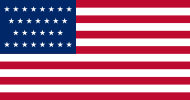 The US flag is modified to have twenty-nine stars, reflecting the addition of one new state: Iowa.
The US flag is modified to have twenty-nine stars, reflecting the addition of one new state: Iowa.
 The North Star, an abolitionist newspaper, begins publication in Rochester, New York. The paper is founded by escaped slave Frederick Douglass (1817-1895), with money he earned as a result of his autobiography.
The North Star, an abolitionist newspaper, begins publication in Rochester, New York. The paper is founded by escaped slave Frederick Douglass (1817-1895), with money he earned as a result of his autobiography.
Liberia is formed as a home for released American slaves.
Missouri bans the education of free blacks.
The Istanbul slave market is abolished.
The Factory Act is passed in Britain. It forbids women and children between the ages of 13 and 18 to work more than 10 hours per day.
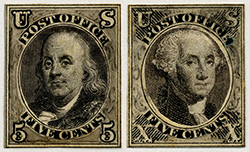 The first United States postage stamps are issued
The first United States postage stamps are issued
1847
Jakob Mathias Schleiden and Theodor Schwann announce that cells are the basic units of all living structures.
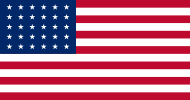 The US flag is modified to have thirty stars, reflecting the addition of one new state: Wisconsin.
The US flag is modified to have thirty stars, reflecting the addition of one new state: Wisconsin.
Slavery is abolished in old French and Danish colonies.
 Karl Marx publishes The Communist Manifesto, which asserts that revolution by the working classes will ultimately destroy capitalism.
Karl Marx publishes The Communist Manifesto, which asserts that revolution by the working classes will ultimately destroy capitalism.
Revolution breaks out across much of Europe; the Second Republic is proclaimed in France.
1848
 On the archetype and homologies of the vertebrate skeleton, by Richard Owen (1804-1892), is published. In the book Owen argues that the skull, and other parts of the body, are formed by the modification of the vertebra of different animals.
On the archetype and homologies of the vertebrate skeleton, by Richard Owen (1804-1892), is published. In the book Owen argues that the skull, and other parts of the body, are formed by the modification of the vertebra of different animals.
Richard Owen describes "homologies" — similarities of design in bird wings, fish fins and human hands.
A Neanderthal skull is excavated from Forbes Quarry on the northern side of the Rock of Gibraltar. Over the next few decades, the skull will be stashed in a library cabinet in Gibraltar, dusted off and sent to London, accurately likened to the ancient skullcap from Neander Valley in Germany, nearly named Homo calpicus, and finally stored and largely forgotten in the Royal College of Surgeons.
 Charles Lewis Reason becomes the first African-American college instructor when he is hired at predominantly white Free Mission College (later New York Central College) to teach Greek, Latin, French, and mathematics.
Charles Lewis Reason becomes the first African-American college instructor when he is hired at predominantly white Free Mission College (later New York Central College) to teach Greek, Latin, French, and mathematics.
 Harriet Tubman escapes from slavery and goes on to lead more than 300 slaves to freedom on the underground railroad.
Harriet Tubman escapes from slavery and goes on to lead more than 300 slaves to freedom on the underground railroad.
 Zachary Taylor becomes twelfth president of the United States.
Zachary Taylor becomes twelfth president of the United States.
The California gold rush begins as more than 100,000 people swarm to California to make their fortunes after gold is found there in 1848.
Showmen Moses Kimball and P. T. Barnum purchase the contents of the Peale Museum (established in 1784).
1849
 Botanist Carl Friedrich von Gärtner (1772-1850) publishes Versuche und Beobachtungen über die Bastarderzeugung im Pflanzenreiche. The book describes thousands of experiments, many involving the production of hybrids, on more than 500 species of plants. Mendel will study this book in detail when he attends the University of Vienna in the early 1850s, and will cite the book in the opening of his paper of 1865.
Botanist Carl Friedrich von Gärtner (1772-1850) publishes Versuche und Beobachtungen über die Bastarderzeugung im Pflanzenreiche. The book describes thousands of experiments, many involving the production of hybrids, on more than 500 species of plants. Mendel will study this book in detail when he attends the University of Vienna in the early 1850s, and will cite the book in the opening of his paper of 1865.
Based on a humerus 58 inches in circumference, Mantell names a new dinosaur species: Pelorosaurus, the first recognized sauropod.
ESP Quick Facts
ESP Origins
In the early 1990's, Robert Robbins was a faculty member at Johns Hopkins, where he directed the informatics core of GDB — the human gene-mapping database of the international human genome project. To share papers with colleagues around the world, he set up a small paper-sharing section on his personal web page. This small project evolved into The Electronic Scholarly Publishing Project.
ESP Support
In 1995, Robbins became the VP/IT of the Fred Hutchinson Cancer Research Center in Seattle, WA. Soon after arriving in Seattle, Robbins secured funding, through the ELSI component of the US Human Genome Project, to create the original ESP.ORG web site, with the formal goal of providing free, world-wide access to the literature of classical genetics.
ESP Rationale
Although the methods of molecular biology can seem almost magical to the uninitiated, the original techniques of classical genetics are readily appreciated by one and all: cross individuals that differ in some inherited trait, collect all of the progeny, score their attributes, and propose mechanisms to explain the patterns of inheritance observed.
ESP Goal
In reading the early works of classical genetics, one is drawn, almost inexorably, into ever more complex models, until molecular explanations begin to seem both necessary and natural. At that point, the tools for understanding genome research are at hand. Assisting readers reach this point was the original goal of The Electronic Scholarly Publishing Project.
ESP Usage
Usage of the site grew rapidly and has remained high. Faculty began to use the site for their assigned readings. Other on-line publishers, ranging from The New York Times to Nature referenced ESP materials in their own publications. Nobel laureates (e.g., Joshua Lederberg) regularly used the site and even wrote to suggest changes and improvements.
ESP Content
When the site began, no journals were making their early content available in digital format. As a result, ESP was obliged to digitize classic literature before it could be made available. For many important papers — such as Mendel's original paper or the first genetic map — ESP had to produce entirely new typeset versions of the works, if they were to be available in a high-quality format.
ESP Help
Early support from the DOE component of the Human Genome Project was critically important for getting the ESP project on a firm foundation. Since that funding ended (nearly 20 years ago), the project has been operated as a purely volunteer effort. Anyone wishing to assist in these efforts should send an email to Robbins.
ESP Plans
With the development of methods for adding typeset side notes to PDF files, the ESP project now plans to add annotated versions of some classical papers to its holdings. We also plan to add new reference and pedagogical material. We have already started providing regularly updated, comprehensive bibliographies to the ESP.ORG site.
ESP Picks from Around the Web (updated 06 MAR 2017 )
Old Science

Weird Science

Treating Disease with Fecal Transplantation
Fossils of miniature humans (hobbits) discovered in Indonesia

Dinosaur tail, complete with feathers, found preserved in amber.
Astronomy

Mysterious fast radio burst (FRB) detected in the distant universe.